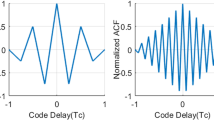Abstract
The dual-frequency constant envelope modulated (DCEM) signals, represented by alternative binary offset carrier signal, have obvious advantages in code tracking accuracy and anti-multipath performance compared with traditional binary phase shift keying signal, and are attracting more and more attention in the field of global navigation satellite system signal design. However, DCEM signal has a multiple-peaked auto-correlation function, which would lead to the tracking ambiguity problem. To deal with this problem, this paper proposes an unambiguous tracking method based on weighted discriminator function (WDF). This method uses the discriminator functions of noncoherent early minus late power (NELP) and sub carrier phase cancellation (SCPC) to generate a linear WDF without no false-lock points. In addition, a simplified version of the proposed WDF method is also provided for interoperable application. The theoretical code tracking error in thermal noise is derived out and verified. The performance of the proposed WDF is evaluated and compared with SCPC and pseudo correlation function methods with the help of simulation. Results show that our method has a significant improvement in code tracking accuracy. Not only the ambiguity threat is efficiently removed, but also the outstanding performance of DCEM signal is maintained.




























Similar content being viewed by others
References
Galileo Open Service Signal In Space Interface Control Document. (2010). OS SIS ICD. Issue 1.1, 4–7.
Lestarquit, L., Artaud, G., & Issler, J. L. (2008). AltBOC for dummies or everything you always wanted to know about AltBOC. In Proceedings of ION GNSS 2008 (pp. 961–970).
Tang, Z., Zhou, H., & Wei, J. (2011). TD-AltBOC: A new COMPASS B2 modulation. Science China Physics Mechanics and Astronomy, 54(6), 1014–1021.
Rebeyrol, E., Julien, O., Macabiau, C., Ries, L., Delatour, A., & Lestarquit, L. (2007). Galileo civil signal modulations. GPS Solutions, 11(3), 159–171.
Zhang, K. (2013). Generalised constant-envelope DualQPSK and AltBOC modulations for modern GNSS signals. Electronics Letters, 49(21), 1335–1337.
Yao, Z., Zhang, J., & Lu, M. (2016). ACE-BOC dual-frequency constant envelope multiplexing for satellite navigation. IEEE Transactions on Aerospace and Electronic Systems, 52(1), 466–485.
Guo, F., Yao, Z., & Lu, M. (2017). BS-ACEBOC: A generalized low-complexity dual-frequency constant-envelope multiplexing modulation for GNSS. GPS Solutions, 21(2), 561–575.
Shivaramaiah, N. C., & Dempster, A. G. (2013). Time-multiplexed offset-carrier QPSK for GNSS. IEEE Transactions on Aerospace and Electronic Systems, 49(2), 1119–1138.
Yan, T., Wei, J., Tang, Z., & Zhou, Z. (2016). General AltBOC modulation with adjustable power allocation ratio for GNSS. The Journal of Navigation, 69(03), 531–560.
Julien, O., Macabiau, C., Cannon, M. E., & Lachapelle, G. (2011). ASPeCT: unambiguous sine-BOC(n, n) acquisition/tracking technique for navigation applications. IEEE Transactions on Aerospace and Electronic Systems, 43(1), 150–162.
Burian, A., Lohan, E. S., & Renfors, M. (2006). BPSK-like methods for hybrid-search acquisition of galileo signals. In Proceedings of IEEE ICC 2006 (pp. 5211–5216).
Shivaramaiah, N. C., & Dempster, A. G. (2015). An analysis of Galileo E5 signal acquisition strategies. In Proceedings of ENC 2015.
Tawk, Y., Botteron, C., Jovanovic, A., & Farine, P. A. (2012). Analysis of Galileo E5 and E5ab code tracking. GPS Solutions, 16, 243–258.
Ren, J., Jia, W., Chen, H., & Yao, M. (2012). Unambiguous tracking method for alternative binary offset carrier modulated signals based on dual estimate loop. IEEE Communications Letters, 16(11), 1737–1740.
Zhu, Y., Cui, X., & Lu, M. (2015). Dual binary phase-shift keying tracking method for Galileo E5 AltBOC(15,10) signal and its thermal noise performance. IET Radar, Sonar and Navigation, 9(6), 669–680.
Hodgart, M. S., & Blunt, P. D. (2007). Dual estimate receiver of binary offset carrier modulated signals for global navigation satellite systems. Electronic Letters, 43(16), 877–878.
Yan, T., Wei, J., Tang, Z., Qu, B., & Zhou, Z. (2014). Unambiguous combined correlation functions for sine-BOC signal tracking. GPS Solutions, 19(4), 623–638.
Chen, H., Wang, R., Jia, W., Ren, J., & Yao, M. (2013). An unambiguous tracking method based on pseudo correlation function for AltBOC(15,10) signal. Wireless Personal Communications, 69, 1347–1364.
Ren, J., Yang, G., Jia, W., & Yao, M. (2014). Unambiguous tracking method based on combined correlation functions for sine/cosine-BOC CBOC and AltBOC modulated signals. Radioengineering, 23(1), 244–251.
Zhou, Y., & Pan, Y. (2015). Unambiguous tracking method for alternative binary offset carrier modulated signals based on pseudo correlation function technique. IEEE Communications Letters, 19(3), 371–374.
Lee, Y., Lee, Y., Yoon, T., Song, C., Kim, S., & Yoon, S. (2009). AltBOC and CBOC correlation functions for GNSS signal synchronization. Proceedings of ICCSA 2009 Part II, LNCS, 5593, 325–334.
Chen, H., Jia, W., & Yao, M. (2014). Unambiguous S-curve shaping technique for multipath mitigation in global navigation satellite systems alternative binary offset carrier signals. Wireless Communications and Mobile Computing, 14, 1500–1508.
Yao, Z., & Lu, M. (2011). Side-peaks cancellation analytic design framework with applications in BOC signals unambiguous. Proceedings of ITM, 2011, 775–785.
Ren, J., Chen, H., Jia, W., & Yao, M. (2013). Complex step-shape binary offset carrier modulation for a unitary analytical framework of GNSS signals. Wireless Personal Communications, 72, 1915–1934.
Yan, T., Wei, J., Tang, Z., Qu, B., & Zhou, Z. (2015). Unambiguous acquisition/tracking technique for high-order sine-phased binary offset carrier modulated signal. Wireless Personal Communications, 84(4), 2835–2857.
Kao, T. L., & Juang, J. C. (2012). Weighted discriminators for GNSS BOC signal tracking. GPS Solutions, 16(3), 339–351.
Acknowledgements
This work is supported by the National Natural Science Foundation of China (NSFC), Grant 61627817.
Author information
Authors and Affiliations
Corresponding author
Additional information
Publisher's Note
Springer Nature remains neutral with regard to jurisdictional claims in published maps and institutional affiliations.
Rights and permissions
About this article
Cite this article
Yan, T., Qu, B., Wang, Y. et al. Weighted Discriminator Function Based Unambiguous Tracking Method for Dual-Frequency Constant Envelope Modulated Signals. Wireless Pers Commun 103, 1895–1925 (2018). https://doi.org/10.1007/s11277-018-5887-y
Published:
Issue Date:
DOI: https://doi.org/10.1007/s11277-018-5887-y




